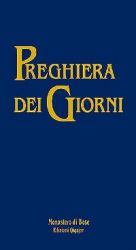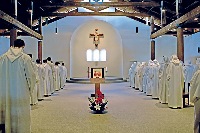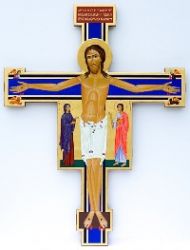1. The plan of the prayer
a) Liturgical times
This book contains the prayer for every day of the liturgical year. In the rhythms and events of time the Church wants to remind us of and to relive the mysteries of our salvation. At the center of the liturgical year is placed the triduum of the Lord’s crucifixion, burial, and resurrection, which culminates on Easter Sunday.
The three days of the Passion and Easter are preceded and prepared by Lent, a time of conversion, hence of struggle against the temptations of the devil, a time of fasting, vigil, and prayer, and are followed by Eastertide, the joyous celebration of the Lord’s Resurrection, a celebration that reaches its fullness at Pentecost, commemoration of the gift of the life-giving Spirit to the Church from the Risen Lord.
Next to the Easter cycle there is the cycle of fixed feasts: Christmas and Epiphany. They too are preceded by a season that is proper to the Western liturgy, which proclaims the Lord’s glorious coming. Expectation and vigilance characterize this time, called Advent, which invokes the Parousia and recalls the manifestation of the Word made flesh that has already occurred in the fullness of time (cf. Gal 4, 4). Advent is traditionally the beginning of the liturgical year, but in fact, according to the most ancient sources, it is its crowning. This is also suggested by what the constitution of Vatican II
Sacrosanctum Concilium 102 says: “During the annual cycle the Church unfolds the whole mystery of Christ, from the incarnation and birth to the ascension, to the day of Pentecost, and up to the awaiting in blessed hope of the Lord’s coming”. The event that is at the center of the celebration of Easter is really the Lord’s glorious coming at the end of time: the Lord Jesus Christ is about to come! the Son of man comes in glory! the day of the Lord is near!
In the thirty-four weeks of ordinary time, which is also called the time of the Church or “per annum”, no particular aspect of the Christian mystery is celebrated; the Christian walks toward the Father in the light of Christ and with the power of the Holy Spirit, recalling every week on Sunday, the Lord’s day, his resurrection, and thus being reminded also of his glorious coming. In this journey the commemoration of the saints manifests their communion with the pilgrim Church in intercession and in the divine life; the feast of the Transfiguration, 6 August, in the middle of summer, is like an epiphany in Christ of what occurs in the life of the Christian day by day: his transfiguration in the image of Christ (cf. 2 Cor 3, 18).
The introductions to morning and evening prayer, the responses, and the orations vary in obedience to the liturgical season being lived.
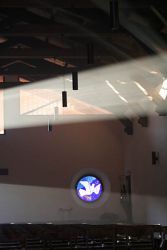
...Sunday, the day of the creation of light...
b) The liturgical week
According to the Christian tradition, the liturgical week begins on Saturday evening with the first vespers of Sunday. Sunday, the day of the creation of light and the day of the Resurrection, of the gift of the Spirit and of the Lord’s coming, is the day when Christians gather in assembly to listen to the Word and for the Eucharistic celebration. In preparation for the Eucharistic liturgy there is a night prayer, a vigil of listening, meditating, and praying the Scripture and also a celebration of the Resurrection at dawn on Sunday. Second vespers and then the traditional prayer of compline close this holy day, in which prayer becomes more intense. The other days of the week are characterized by the cursive prying of the Psalter and the reading of Sacred Scripture. A faint copy of the paschal triduum, however, is given by the Psalms and orations of Friday, Saturday, and Sunday. On those days, in fact, Psalms and orations follow the course of the paschal event: the passion, death, burial, repose in the tomb, and resurrection of Jesus Christ.
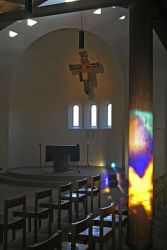
the morning light through the window
c) The liturgical day
This is marked by the three hours of evening, morning, and midday, to which may be added the prayer of compline. In the morning, in addition to the Psalms, the prayer includes the reading of the Old Testament and of the Gospel, the canticle of “Benedictus” or “Christ the new sun”, contemplations of praise or of doxology, the morning collect, and the Lord’s prayer, the “Our Father”. In the evening the Epistles are read; the “Magnificat” is followed by intercessions, which in turn are followed by the evening collect. At the midday hour, besides the psalmody, there is a patristic or spiritual reading on the day’s Gospel, which is recalled through the proclamation of a verse (chapter).
2. The structure of the prayer
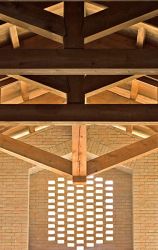
ceiling of the nathex
a) Introduction
Every prayer, be it evening, vigil, morning, or midday, during the week begins with the traditional verses of the Latin rite: “ Lord, open my lips…God, come to my aid…”. Sunday prayer, on the contrary, is introduced by Byzantine formulas, which are more festive and doxological and better characterize the particular or special joy of the Lord’s day. In Advent, Christmas-Epiphany, Lent, and Eastertide introductory verses taken from Scripture, which can be sung by a soloist as an announcement to the assembly, define with their theological message the liturgical season being celebrated. The singing of the “Glory be to the Father…”, a profession of Trinitarian faith, closes the introduction.
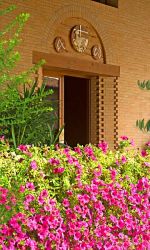
front door
b) Hymn
The invocations of the introduction are followed by a hymn, a church composition that evokes the hour of the day and the mystery of the season or of the feast that is being celebrated. Although our community possesses a Hymn Book containing a wide selection of hymns, especially translations of the classical hymns of the Latin office, they are not included here, in the Book of daily prayer, so as to leave the choice to communities who may and should express themselves in a different way, according to their own repertory. It should be stressed, however, that the hymn is an important element of the office and that its spiritual and poetic quality expresses and reveals the quality of a community’s faith and Christian life.
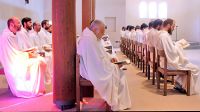
the brothers' choir
c) Psalmody
Psalmody, understood as an integral and cursive praying of the Psalter, is traditional in the Church. This volume contains both the 150 Psalms, fully and without omissions, and the biblical canticles of the Old and New Testaments.
Various distributions of the Psalms are suggested for prayer: over four weeks (the liturgy of the hours according to the Roman rite, p.748–749), over two weeks (monastic psalmody of Bose A, p.750), over four weeks (suitable for a simpler and shorter prayer, psalmody of Bose B, p.754–755).
Each distribution takes into account the hour of the day (morning, evening, and night Psalms) and also of Friday (Passion Psalms), of Saturday (Psalms of creation and alliance), and of Sunday (Christological and festive Psalms). Moreover, there is a distribution of Psalms for festive seasons (the season of Christmas-Epiphany and the octaves of Easter and Pentecost: p.751) and a distribution for the celebration of saints’ feasts (p.752–753).
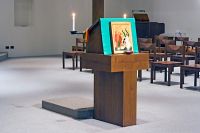
the ambo
d) The reading of Sacred Scripture
The Book of daily prayer gives two readings, one from the Old Testament and one from the Gospel, in the morning and a reading of the Epistle in the evening.
The Bible, distributed according to the weekday lectionary of Bose, is thus read almost in its entirety: the Old Testament in a cycle of three years (A, B, and C), the New Testament (Gospel and Epistle) in its entirety in the course of one year. Only those passages of the Old Testament are omitted which with difficulty can be the object of a lectio divina or provide enough daily food to nourish the faith.
The choice of books seeks both to respect the economy of liturgical seasons and to obey the principle of continuity. We believe that the weekday lectionary presented here, the fruit of years of work and experimentation, can help the Christian do the lectio divina daily, reading practically all the Scripture without great jumps.
The Sunday lectionary is that of the Catholic Church, a lectionary that on account of its spiritual intelligence has been adopted as well by some Reformed Churches. Nevertheless, we have wanted to suggest some further texts, which we always write in italics and mark with an asterisk, to provide Old Testament parallels that fit the Gospel better and to include also the second reading (Epistle) in the parallel lectio. The texts in italics and marked with an asterisk, hence, are to be viewed as suggestions of our community should the lectionary be revised.
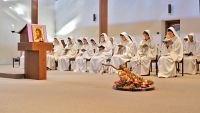
the sisters' choir
e) Responses
Between the readings of the Old Testament and the Gospel stand responses, which have the function of answering with praise the proclamation of the Word. These consist of an Old Testament text, the singing of which by a soloist is broken up by an antiphon from the New Testament sung by all, which interprets the text most often Christologically, sometimes eschatologically or ecclesiologically. The responses in this way arrange in unity the Old and the New Testament and at the same time indicate the liturgical period in which the Scripture reading takes place.
The evening responses, shorter than those in the morning, are always executed alternately by soloist and assembly, which picks up a part of the text sung by the soloist, and correspond to the reading of the Epistle. Almost always the text is drawn from the monastic Thesaurus.
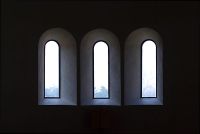
triple lancet window in the apse
f) Silence
Silence is an essential element of the liturgy (cf. SC 30)! Its function is to aid meditation of the Scriptures, hence should not be too short. It should allow the Word of God to be fixed in mind and heart so that it may be retained and meditated through the following hours.
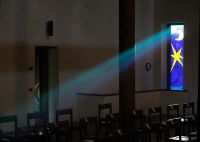
stained-glass window
g) Canticle of the New Testament
This is the traditional canticle of the “Benedictus” in the morning of the “Maginificat” in the morning, and of the “Nunc dimittis” at compline.
h) Contemplations and intercessions
These are prayers drawn from the treasure of all the Christian Churches and, on Saturday morning, from the prayer of the synagogue; they are introduced by a fitting invitatory verse taken from Scripture and adapted to the liturgical season. Morning contemplations are professions of faith, adoration, glorification, acclamation, and blessing of the One God or of the Lord Jesus Christ, while evening intercessions are prayer for all mankind, for the Churches, for the community, for our brothers and sisters. On Thursdays the contemplations are addressed to Christ, Lord and Pastor, and the intercessions have for their object the Church and her pastors: in particular, where is found N.N., this is a sign that here should be inserted the name of the pope, of the patriarchs, of the bishop, of other ministers of the Church, priests, deacons, missionaries, and of whoever presides over the community. On Fridays are commemorated Christ’s passion and death, the sufferings of Christians and of other men, while on Saturdays we pray in communion with the people of the first alliance, which has never been revoked, while awaiting the glorious coming of the Messias. On Sundays in the various offices is contemplated the mystery of the Father, of the Son, Jesus Christ Risen, of the life-giving Holy Spirit, while the great intercession of the Eucharistic liturgy gathers together the intentions of the faithful.
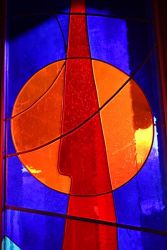
stained-glass window, detail
i) Free intentions
Every community, or every individual in the case of private celebration, ends the intercessions with a free prayer that mentions the needs of the moment. In this way the community presents to God the day’s happenings, commemorates loved ones, those who had asked its prayers, and also enemies and adversaries, as the Gospel demands (cf. Mt 5, 44; Lk 6, 28). This is to make the intercession fully meaningful for the present moment. It must be remembered that the formula of the intentions should be sober; it ought not become a monologue or acquire a length and importance that are excessive in relation to the rest of the office. Here too the community’s spiritual quality becomes evident!
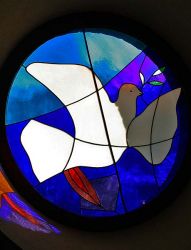
stained-glass window
j) Common oration and proper oration
The common oration is a collect that evokes the moment of the day (morning, evening), the work that awaits the Christian, the nightly rest, and, above all, the liturgical season that is being lived and its demands:
• vigilance and expectation in Advent
• joyful contemplation of the incarnation during the season of Christmas-Epiphany
• conversion, ascesis, and repentance in Lent
• joy of the resurrection at Eastertide
At Sunday vespers, on feasts and commemorations the common oration is replaced by a proper oration that inserts the prayer in the mystery being celebrated. The Sunday proper orations are taken from the Roman liturgy, retranslated from the Latin and sometimes retouched with elements from the ancient tradition. The proper orations, when they are not found in the proper liturgy, are in the lectionary (p.637ff) and in the sanctoral (p.709ff).

the apse
k) The Lord’s prayer (Our Father)
This ends the office: it is the prayer taught us by Christ, the norm of all Christian prayers. It is always introduced by a verse taken from the New Testament. The Lord’s prayer has reached us in the versions of Matthew (6, 9–13) and of Luke (11, 2–4). We write them out here. Luke’s version, which contains the request for the Holy Spirit, may be more fittingly prayed in the morning and that of Matthew in the evening, where it is to be inserted after the common or proper oration, before the benediction.
Matthew’s version
Our Father in heaven, hallowed be your name. Your kingdom come. Your will be done on earth as it is in heaven. Give us this day our daily bread. And forgive us our debts as we also forgive our debtors. And do not lead us into temptation, but deliver us from evil. Yours are the kingdom and the power and the glory for ages. Amen.
Luke’s version
Father, hallowed be your name. Your Spirit come upon us and cleanse us. Give us each day our daily bread. And forgive us our sins, for we ourselves forgive everyone indebted to us. And lead us not into temptation. Yours are the kingdom and the power and the glory for ages. Amen.

stone basin at the entrance of the church
l) Benediction
This is a formula of blessing taken from Scripture (Old Testament and Epistles), recited by whoever presides at the prayer.
In case of individual prayer, the truthfulness of the prayer requires that it be adapted to the situation, for example, by omitting the parts in dialogue…
(From: Comunità monastica di Bose, Preghiera dei Giorni, Gribaudi, Torino, 1996 pp. XI-XIX)
